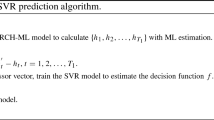Abstract
As GARCH models and stable Paretian distributions have been revisited in the recent past with the papers of Hansen and Lunde (J Appl Econom 20: 873–889, 2005) and Bidarkota and McCulloch (Quant Finance 4: 256–265, 2004), respectively, in this paper we discuss alternative conditional distributional models for the daily returns of the US, German and Portuguese main stock market indexes, considering ARMA-GARCH models driven by Normal, Student’s t and stable Paretian distributed innovations. We find that a GARCH model with stable Paretian innovations fits returns clearly better than the more popular Normal distribution and slightly better than the Student’s t distribution. However, the Student’s t outperforms the Normal and stable Paretian distributions when the out-of-sample density forecasts are considered.
Similar content being viewed by others
References
Akaike H (1978) Time series analysis and control through parametric models. In: Findley DF (ed) Applied time series analysis. Academic, New York
Bidarkota PV, McCulloch JH (2004) Testing for persistence in stock returns with GARCH-stable shocks. Quant Finance 4:256–265
Blattberg RC, Gonedes NJ (1974) A comparison of the stable and Student distributions as statistical methods for stock prices. J Bus 47:244–280
Bollerslev T (1986) Generalized autoregressive conditional heteroskedasticity. J Econom 31:307–327
Bollerslev T (1987) A conditional heteroskedastic time series model for speculative prices and rates of return. Rev Econ Stat 69:542–547
Bollerslev T, Chou RY, Kroner KF (1992) Arch modeling in finance. J Econom 52:5–59
Box GEP, Tiao GC (1962) A further look at robustness via Bayes theorem. Biometrika 49:419–432
Engle RF (1982) Autoregressive conditional heteroskedasticity with estimates of the variance of United Kingdom inflation. Econometrica 50(4):987–1006
Engle RF, Bollerslev T (1986) Modelling the persistence of conditional variances. Econom Rev 5:1–50
Fama EF (1965) The behavior of stock prices. J Bus 38:34–105
Granger C, Ding Z (1995) Some properties of absolute return, an alternative measure of risk. Ann Econ Stat 40:67–91
Hansen PR, Lunde A (2005) A forecast comparison of volatility models: does anything beat a GARCH(1,1)? J Appl Econom 20:873–889
Hsieh DA (1989) The statistical properties of daily foreign exchange rates: 1974–1983. J Int Econ 24:129–145
Hurvich CM, Tsai CL 1989 Regression and time series model selection in small samples. Biometrika 76:297–307
Jarque CM, Bera AK (1987) A test for normality of observations and regression residuals. Int Stat Rev 55(2):163–172
Ljung GM, Box GEP (1978) On measure of lack of fit in time series models. Biometrika 65:297–303
Liu SM, Brorsen BW (1995) Maximum likelihood estimation of a GARCH-stable model. J Appl Econom 10:273–285
Mandelbrot B (1963) The variation of certain speculative prices. J Bus 36:394–419
Mittnik S, Rachev S T (1993) Modeling asset returns with alternative stable models. Econom Rev 12:261–330
Mittnik S, Paolella MS, Rachev ST (1998) Unconditional and conditional distributional models for the Nikkei Index. Asia Pac Financ Mark 5:99–128
Mittnik S, Rachev ST, Doganoglu T, Chenyao D (1999) Maximum likelihood estimation of stable Paretian models. Math Comput Model 29:275–293
Mittnik S, Paolella MS (2003) Prediction of financial downside risk with heavy-tailed conditional distributions. In: Handbook of heavy tailed distributions in finance, vol 1, chap 9, Elsevier/North-Holland, New York.
Nelson DB (1991) Conditional heteroskedasticity in asset returns: a new approach. Econometrica 59(2):347–370
Panorska A, Mittnik S, Rachev ST (1995) Stable ARCH models for financial time series. Appl Math Lett 8:33–37
Poon S, Granger C (2003) Forecasting volatility in financial markets: a review. J Econ Lit 41:478–539
Rachev S, Mittnik S (2000) Stable Paretian models in finance. Wiley, New York
Samorodnitsky G, Taqqu MS (1994) Stable non-Gaussian random processes. Stochastic models with infinite variance. Chapman and Hall, London
Schwarz G (1978) Estimating the dimension of a model. Ann Stat 6:461–464
Sin CY, White H (1996) Information criteria for selecting possibly misspecified parametric models. J Econ 71:207–225
Author information
Authors and Affiliations
Corresponding author
Rights and permissions
About this article
Cite this article
Curto, J.D., Pinto, J.C. & Tavares, G.N. Modeling stock markets’ volatility using GARCH models with Normal, Student’s t and stable Paretian distributions. Stat Papers 50, 311–321 (2009). https://doi.org/10.1007/s00362-007-0080-5
Received:
Revised:
Published:
Issue Date:
DOI: https://doi.org/10.1007/s00362-007-0080-5




